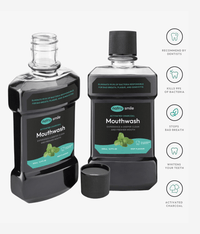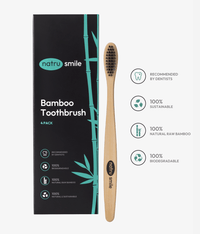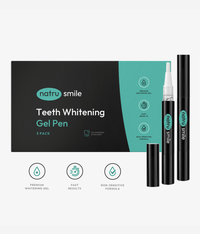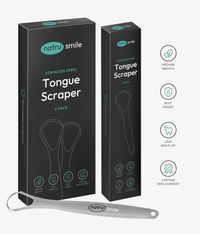
All products are certified by dental expert Dr. Greg Grillo
After braces removal, your dentist will send you home with a retainer—a custom-made, removable appliance that holds your teeth in place and prevents them from shifting back to their original positions.
Hawley retainers are one of the most popular retainer types, thanks to their durability and affordability.
In this article, we'll tell you everything you need to know about Hawley retainers, so you can prepare for the next step in your orthodontic journey.
What Is A Hawley Retainer And How Does It Work? Overview
A Hawley retainer is a type of removable orthodontic retainer commonly used to help maintain the results of orthodontic treatment. It combines hard plastic or acrylic material and a thin metal wire. The retainer is custom-fitted to each patient's mouth, fitting comfortably and securely.
The Hawley retainer works by applying gentle pressure to teeth, which helps to keep them in their new, straighter position while the surrounding gum and bone tissue adjust to the changes. The metal wire in the retainer can be adjusted to tighten or loosen the pressure on teeth and can also be used to make minor adjustments to their position if needed.
Preferred by over 90% of dentists, Hawley retainers are long-lasting, easy to customize and adjust, and highly effective in preventing orthodontic relapse.
Advantages And Disadvantages Of Hawley Retainer
Like all teeth retainers, Hawley retainers have their own set of advantages and disadvantages. Let's take a look at why they're so well-loved by dentists and what other retainers might do better.
Pros Of Hawley Retainers
Advantages of Hawley retainers include:
-
Customizable: Hawley retainers are custom-made to fit each patient's mouth, so they are comfortable to wear and hold securely.
-
Practical: The metal wires in the Hawley retainer allow adjustments to be made, making them more effective at maintaining the results of orthodontic treatment. Patients who need configuration later in the orthodontic process can do so with minimal cost and effort.
-
Straightforward application: Hawley retainers are easy to use and clip right into patients’ mouths. Since they are worn overnight (after the first six months), they shouldn’t bug patients throughout the day.
-
Durable: Hawley retainers are made from durable materials that withstand normal wear and tear. Most Hawley retainers last between five and ten years with proper care.
-
Removable: Hawley retainers can be removed for eating and brushing, meaning you can keep your mouth clean and healthy.
- Cost-effective: Hawley retainers are often less expensive than other orthodontic retainers.
Cons Of Hawley Retainers
Hawley retainers also have some disadvantages, including:
-
Frequent adjustments: The metal wire in the retainer may require frequent adjustments if teeth move or shift during treatment. This means that patients must visit their orthodontist regularly to have the retainer adjusted.
-
Visible: The metal wire that runs across the front of the teeth makes the Hawley retainer visible when it is being worn, which some patients may find unappealing. Some patients may even feel self-conscious wearing it in public.
-
Bulky: Hawley retainers are bulkier than other types of retainers, which can make them uncomfortable to wear for some patients.
-
Speech impediment: Patients may experience a slight speech impediment when wearing the Hawley retainer, particularly in the first few weeks of wear.
-
High maintenance: The intricate design of the Hawley retainer makes it difficult to clean thoroughly and can lead to bacteria build-up if it isn't adequately maintained.
- Discomfort: Some patients may experience discomfort or soreness when first wearing the Hawley retainer, particularly during the initial adjustment period.
Hawley Retainer: Before And After (images)
Before and after Hawley retainer use—slight realignment to close a gap in the teeth.
Before and after Hawley retainer plus dental bonding for significant realignment.
Hawley Retainer Colors
Hawley retainers are available in a variety of colors and designs to make them more appealing and fun to wear.
While the wire component of the retainer is typically silver or gold in color, the plastic component can be made in a wide range of colors, including clear, pink, blue, green, and purple, among others. Some orthodontists may even offer custom designs or patterns for Hawley retainers.
Patients can choose the color of their Hawley retainer to match their personal style or to express their individuality. Younger patients may enjoy picking bright, fun colors or designs, while older patients usually prefer more subtle or natural colors (i.e., gum-colored pink or clear).
Patients may also choose to change the color of their retainer periodically, giving them the opportunity to switch up their look.
It's important to note that while the color of the plastic component of the retainer can be customized, the metal wire cannot be colored. Some patients may opt for a clear plastic component—which makes the retainer less visible when being worn—but this is the only other customizability option.
What Are Hawley Retainers Made Of?
The Hawley retainer is made of a combination of hard plastic or acrylic material and a thin metal wire.
Hawley retainers are usually created with polymethyl methacrylate (PMMA), a type of acrylic material. This is deemed safe to use in the mouth but can cause contact allergy or sensitivity for some patients, resulting in symptoms like itching, swelling, and redness around their lips and/or inside their mouths—particularly within the first days of use.
The metal wire is usually made of stainless steel, but other metals, such as titanium or gold, may also be used. It is strong but flexible, which allows it to be customized to fit the patient's teeth.
How To Clean Hawley Retainer
Proper care and maintenance are vital for the long-term success of your Hawley retainer.
Improper care may lead to bacteria build-up that can cause plaque and oral health problems.
Here are some steps to follow for cleaning a Hawley retainer:
-
Rinse your retainer. After removing the retainer from the mouth, rinse it thoroughly with cool or lukewarm water. This will help remove any loose debris or particles.
-
Brush your retainer. Use a soft-bristled toothbrush, mild dish soap, or a non-abrasive cleaning solution to gently brush the retainer. Be sure to clean all surfaces of the retainer, including the plastic or acrylic material and the metal wire.
-
Rinse your retainer again. After brushing, rinse the retainer thoroughly with cool or lukewarm water to remove any remaining cleaning solution or debris.
-
Soak your retainer in cool water. To help remove any bacteria or buildup, soak the retainer in a retainer cleaning solution or a mixture of equal parts white vinegar and water for 15-30 minutes. Rinse the retainer thoroughly with water after soaking.
- Store your retainer properly. When you aren’t using it or cleaning it, store the retainer in a protective case to prevent damage or contamination. Do not store the retainer in a hot or humid area.
Hawley retainers should never be cleaned with hot water or abrasive cleaners, as this can damage the retainer and cause it to lose its effectiveness.
Patients should also avoid using mouthwash or other alcohol-based solutions to clean their retainers, as these can cause the plastic or acrylic material to become brittle and break over time.
How To Care For Your Hawley Retainer
To ensure your retainer lasts as long as possible, there are a few things you need to do in addition to cleaning it properly.
Follow these tips to keep your Hawley retainer safe from damage and maintain its effectiveness:
-
Handle the retainer with care. Always be gentle when handling your retainer, as it can be fragile due to the thin metal wire.
-
Don't store your retainer in hot or humid environments. Heat and humidity can cause the plastic material to warp, making it less effective and possibly damaging it beyond repair.
-
Avoid wearing your retainer during strenuous activities. Playing sports or exercising can cause the retainer to come out of place, making it difficult to wear when needed.
-
Don't wear the retainer for long periods. Wearing the retainer for extended periods of time (more than 15 hours a day) may cause the plastic material to warp and become ineffective.
-
Wear your retainer only as directed. Follow your orthodontist's instructions for wearing your retainer, including how often and for how long to wear it. Failure to wear your retainer as directed can cause your teeth to shift back to their original position.
- Attend your routine orthodontic check-ups. Make sure to attend your scheduled appointments with your orthodontist to ensure your retainer is working as expected and that your teeth are not shifting back into their original position.
By properly caring for and cleaning your Hawley retainer, you can enjoy the benefits of a straight smile without worrying about it becoming ineffective or damaged over time.
Hawley Retainer Vs. Esssix Retainer
When it comes to choosing a retainer, there are two main types available: the Hawley retainer and the clear plastic retainer (Essix retainer).
Let's examine their key differences:
-
Design: Hawley retainers consist of molded plastic or acrylic material that sits behind the teeth, along with a thin metal wire that runs across the front of the teeth. Essix retainers are made from a clear thermoplastic material that fits snugly over the teeth. They resemble a clear, removable mouthguard (such as an Invisalign tray) and are virtually invisible when worn.
-
Comfort: Hawley retainers usually require more time to get used to, as they can feel bulky in your mouth compared to the thin material of an Essix retainer. Since they take up some space in the back of the mouth, they also cause patients to talk with a lisp in the beginning.
-
Fit: Essix retainers provide a more precise fit to the teeth than Hawley retainers, designed to fit snugly over the entire set of teeth. Since Hawley retainers have an open design, they don't always provide the same level of precision and can require adjustment from time to time.
-
Adjustability: Although Essix retainers fit the teeth better, they can't be reconfigured the same way a Hawley retainer can. Thus, Hawley retainers are considered more adjustable and easier to adjust than Essix retainers.
-
Durability: Both types of retainers are durable and long-lasting if cared for properly. Since Hawley retainers have metal components, they tend to be a bit sturdier and less prone to breakage than Essix retainers.
-
Additional protection: Essix retainers cover the entire tooth, so they protect against teeth grinding (bruxism). This causes them to wear down more quickly, but it also provides an extra layer of defense that Hawley retainers don't provide.
-
Maintenance: Hawley retainers require regular cleaning with a soft-bristled toothbrush and a mild dish soap or retainer cleaning solution. Clear retainers are typically easier to clean and may only require a rinse with cool or lukewarm water. However, clear retainers can become discolored over time and may need to be replaced more frequently than Hawley retainers.
- Cost: Typically, the cost of a Hawley retainer is higher compared to clear plastic Essix retainers. But Hawley retainers are designed to last for several years, making them more durable than plastic Essix retainers. In some cases, the cost of a Hawley retainer is bundled into the overall price of orthodontic care.
In short, Hawley retainers are best for people who require more precise adjustments to their teeth, while Essix retainers are better for those who want an invisible retainer and don't need frequent adjustments.
The Cost Of A Hawley Retainer
On average, a Hawley retainer costs between $150 and $300. The exact cost depends on the complexity of your orthodontic treatment, as well as any additional materials or services needed (such as a retainer case or cleaning solution).
Some orthodontists offer a discounted price when you bundle the cost of your retainer into an overall orthodontic package. Other practices may offer financing options to help spread out the cost of your retainer over time.
That said, retaining a newly aligned smile is as important as achieving it in the first place. Avoiding a retainer because of its cost means you run the risk of undoing your orthodontic treatment—which likely cost you thousands of dollars.
Want to learn more? These are the questions our customers ask us the most.
How Long Do You Have To Wear A Hawley Retainer?
The duration of time a patient should wear a Hawley retainer varies depending on the individual case. In general, orthodontists recommend wearing the retainer for at least six months after the completion of orthodontic treatment. After this initial period, the retainer should be worn nightly for as long as possible to maintain the treatment results.
Can Teeth Move With Hawley Retainer?
While Hawley retainers are designed to maintain the position of teeth after orthodontic treatment, they cannot prevent teeth from moving entirely. Over time, the natural shifting of the teeth can occur, which may require further orthodontic treatment. Regularly using a Hawley retainer as directed by an orthodontist usually minimizes the risk of orthodontic relapse.
Is Hawley Retainer Better Than Plastic?
Hawley retainers and clear plastic retainers each have their advantages and disadvantages. Hawley retainers are more durable and adjustable but are more visible and require more maintenance. Clear plastic retainers are more discreet and require less maintenance but aren't adjustable and wear down more quickly.
The best type of retainer depends on the individual case and the patient's preferences.
Can I Wear My Hawley Retainer Only At Night?
Orthodontists generally recommend wearing a Hawley retainer for as long as possible after the completion of orthodontic treatment. While wearing the retainer only at night may be an option for some patients, it may not be enough to maintain the results of the treatment. Patients should follow their orthodontist's recommendations for wearing their retainer.
Can I Eat With Hawley Retainers?
Hawley retainers should be removed during meals to prevent damage or contamination. Patients should also avoid drinking sugary or acidic beverages while wearing the retainer, as this can increase the risk of tooth decay and cause the metal wiring to tarnish. After eating or drinking, patients should brush their teeth and rinse their retainer with cool or lukewarm water before reinserting it.
How Often Should I Wear My Hawley Retainer?
Orthodontists usually recommend wearing a Hawley retainer every night, as long as possible, to maintain the results of orthodontic treatment. The frequency of use may vary depending on the individual case, and orthodontists may adjust the wearing schedule as necessary.
Are Hawley Retainers Removable?
Yes, Hawley retainers are removable. Patients can remove their retainer to eat, brush their teeth, or for other activities as needed and most retainers are designed to be worn at night. Still, patients should wear the retainer as directed by the orthodontist to maintain the results of orthodontic treatment.
Are Hawley Retainers Comfortable?
Hawley retainers can be comfortable to wear, but it may take some time for patients to get used to the feeling of the retainer in their mouth. If the retainer causes discomfort or irritation, patients should speak to their orthodontist to adjust the fit. It's also important to ensure that the retainer is worn correctly and is not too loose or tight.
Are Hawley Retainers Supposed To Hurt?
Hawley retainers shouldn't cause significant pain or discomfort when worn as directed. Patients may initially experience some soreness or discomfort as their mouth adjusts to the retainer, but this is almost always temporary. If the retainer is causing significant pain or discomfort, patients should contact their orthodontist for further evaluation and adjustments.
Are Hawley Retainers Permanent?
Hawley retainers are not considered permanent, but they are designed to be durable and long-lasting. With proper care and maintenance, a Hawley retainer can last several years (between 5-10 normally) but will certainly need to be replaced eventually. This is especially true for patients who avoid wearing their retainer for an extended period of time.
Can Hawley Retainers Straighten Teeth?
Sometimes, a retainer is all a patient needs to straighten their teeth (i.e., in the case of minor misalignment). But Hawley retainers are not designed to straighten teeth—their main purpose is to maintain the results of orthodontic treatment. Additional orthodontic treatment is usually required if a patient's teeth require further alignment.
Can A Hawley Retainer Be Adjusted?
Yes, Hawley retainers can be adjusted as needed by an orthodontist. The metal wire component of the retainer can be bent or adjusted to tighten or loosen the pressure on the teeth. If a patient experiences discomfort or if their teeth begin to shift, they should contact their orthodontist to have their retainer adjusted.
Can A Hawley Retainer Fix An Overbite?
Hawley retainers are not designed to fix an overbite, but they can help maintain the results of orthodontic treatment for an overbite. Additional orthodontic treatment, such as braces or clear aligners, is required for patients with overbite.
Can Hawley Retainers Close Gaps?
Although they can sometimes close small gaps, Hawley retainers are mainly designed to help maintain the results of other orthodontic treatment for gap closure (i.e., braces). If a patient has a significant gap in their tooth, braces treatment is almost always the suggested option.
Can Hawley Retainers Be Repaired?
If a Hawley retainer is damaged or broken, it may be able to be repaired by an orthodontist. The extent of the damage and the age of the retainer may affect whether or not it can be repaired, and the repair cost may vary.
How Should A Hawley Retainer Fit?
A Hawley retainer should fit snugly against the roof of the mouth or the bottom of the teeth, with the metal wire component settled against the front of the top teeth. The retainer should be comfortable to wear (after the first few days) and should not cause significant pain or discomfort.
Where Can I Buy A Hawley Retainer?
Retainers are privately ordered through an orthodontist, who will take impressions of the patient's teeth and create a custom-fitted retainer. Patients should not purchase retainers from online retailers as these may not fit properly and can cause discomfort or damage to the teeth.










